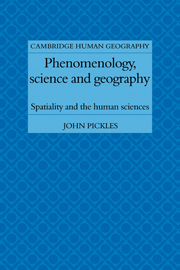Book contents
- Frontmatter
- Contents
- Preface
- Acknowledgements
- 1 Introduction
- PART I GEOGRAPHY AND TRADITIONAL META-PHYSICS
- PART II GEOGRAPHY AND PHENOMENOLOGY
- PART III PHENOMENOLOGY AND THE QUESTION OF HUMAN SCIENCE
- 5 Husserlian phenomenology: the foundational project
- 6 Phenomenology, science and phenomenological geography
- 7 Towards a fundamental ontology of science
- PART IV HUMAN SCIENCE, WORLDHOOD AND SPATIALITY
- Notes
- References
- Index
6 - Phenomenology, science and phenomenological geography
Published online by Cambridge University Press: 07 September 2010
- Frontmatter
- Contents
- Preface
- Acknowledgements
- 1 Introduction
- PART I GEOGRAPHY AND TRADITIONAL META-PHYSICS
- PART II GEOGRAPHY AND PHENOMENOLOGY
- PART III PHENOMENOLOGY AND THE QUESTION OF HUMAN SCIENCE
- 5 Husserlian phenomenology: the foundational project
- 6 Phenomenology, science and phenomenological geography
- 7 Towards a fundamental ontology of science
- PART IV HUMAN SCIENCE, WORLDHOOD AND SPATIALITY
- Notes
- References
- Index
Summary
Descriptive phenomenology and science
Sciences of fact and sciences of essence
Husserl asks whether science can be ‘exact’ if it leaves its concepts without scientific fixation and without methodical elaboration. He answers: surely it would be no more so than a physics that would be content with the everyday concepts of heavy, warm, etc. But how can everyday experience become scientific experience? How does one arrive at the determination of objectively valid empirical judgements? Historically this occurred as the pioneers of empirical science intuitively grasped the necessary method, and, by pursuing it faithfully in an accessible sphere of experience, achieved some objectively valid insights thus getting science started (Husserl, 1911, 99–100). By contrast, Husserl's guiding idea “of a science that shall be established as radically genuine, ultimately an all-embracing science” (Husserl, 1930, 7), “a science covering a new field of experience, exclusively its own, that of ‘Transcendental Subjectivity’” (Husserl, 1913, 5), and a science to counter the growing dominance of “sciences of fact” (Husserl, 1907, 33), requires explicit methods and a framework in which empirical, formal and transcendental aspects of the science of science can be developed.
In the natural standpoint the world is the totality of objects that can be known through experience. The sciences of the world, including the natural sciences (the sciences of material nature), biological sciences (the sciences of psycho-physical nature) and the human sciences (the cultural and sociological disciplines), each corresponds to its own object-domain in that world (Husserl, 1913, 46).
- Type
- Chapter
- Information
- Phenomenology, Science and GeographySpatiality and the Human Sciences, pp. 107 - 120Publisher: Cambridge University PressPrint publication year: 1985



